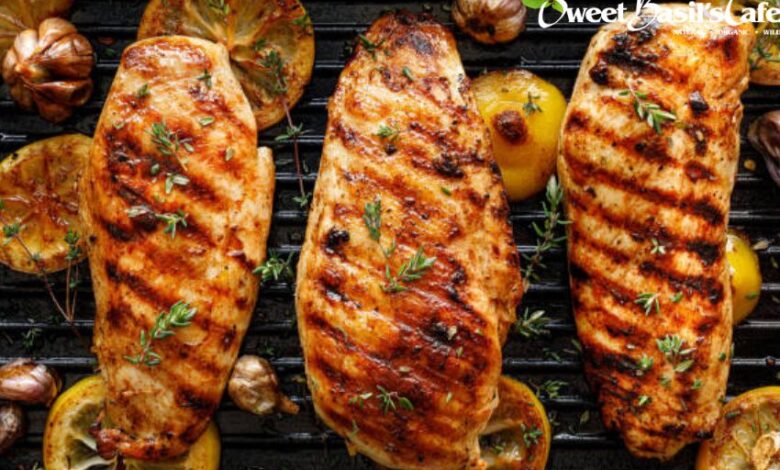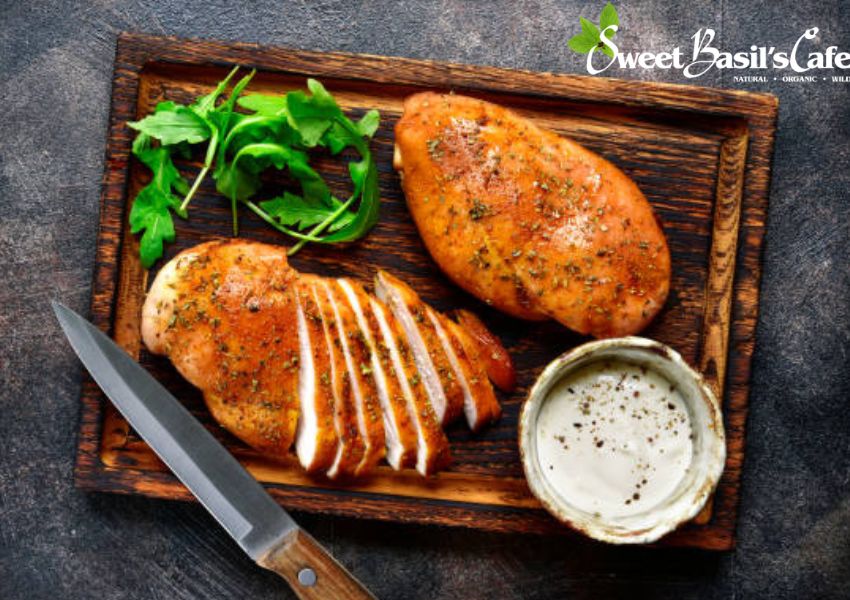Why Is My Chewy Chicken?

Why is your chewy chicken? Have you ever taken a bite of chicken that was strangely too chewy, almost to the point where it’s hard to swallow? This is an all-too-common complaint among even the most experienced cooks. From burnt BBQ drumsticks to toughened breasts, why is it so easy for chicken dishes to become overcooked? In this blog post, I’ll be exploring some of the main culprits behind the dry and rubbery chicken. Not only will you discover what makes your favorite poultry dish go astray but also gain insight into how to perfectly cook juicy and succulent chicken every time.
Chewy Chicken
If chicken is overdone, undercooked, or left out too long, it may become very chewy chicken. Possible causes of chewy chicken include woody breasts and a muscular issues. Cook white meat to 165 degrees and dark meat to 180 degrees for the best results, and if possible, start with locally sourced ingredients.

White Meat Vs. Dark Meat
After learning briefly about chewy chicken. Let’s go through the main distinctions between the breast, sometimes referred to as the white flesh, and the darker meat of the leg and thigh before we get started.
When white meat is cooked just long enough to kill any potentially harmful bacteria, it is at its best. The ideal temperature for chicken breast is 165 degrees Fahrenheit, but if you watch the thermometer, you can remove the chicken from the heat a little earlier. As the meat sits, the temperature will slightly increase.
Meanwhile, thighs and drumsticks need to cook a little bit longer. When the dark meat is cooked to 180 degrees, it tastes better. This is due to the fact that it has a considerable amount of collagen, which, at higher temperatures, decomposes and moisturizes the flesh.
Why The Cluck Is My Chicken Chewy?
Your chicken’s chewy texture can be attributed to a number of factors.
- The rubber-like texture of your chicken may be the result of overcooking. A chicken that has been cooked in a skillet, oven, or grill for a little too long may have lost all of its moisture, leaving you with a dry, rubbery bird. The protein fibers in the chicken become stretchy in the absence of moisture.
- It can also matter what kinds of chicken you purchase at the grocery store. Two problems that might impact the texture of the flesh in farmed fowl are “woody breast” and “white striping.” (Oh, how self-centered – birds growing sick and becoming tougher to eat. Stupid little humans.
- A 2016 research found that chicken with woody breasts has a harder consistency from swollen muscles. These are more difficult to chew than non-woody chicken, similar to how The Rock can be challenging to consume without at least mayo.
- White fatty stripes that are parallel to the chicken muscle fibers might appear on the delicate muscles, thighs, and breasts as a result of a condition called “white striping.”
Both may have an impact on the overall caliber of your chicken.
What Makes Chewy Chicken?
We are aware that various factors can affect how chicken behaves, but why? Why do these circumstances cause the flesh to degrade? The chicken crossed the road, but why? All types of issues are raised by chickens.
Woody chicken breast has more connective tissue than regular breast flesh, which can make the meat difficult, claims a 2020 study. This and white striping may both be caused by hens’ accelerated growth rates.
A 2019 study on broiler chickens discovered a substantial relationship between woody breast and body weight as well as an increase in the severity of the condition as the chicks aged and expanded. The study also hints that blood vessel damage is probably a key puzzle component.
Undercooking
Because the chewy chicken texture can be a factor for numerous reasons, I made sure to note the distinction between the thigh and breast flesh. Some of them change depending on the cut you’re using.
As previously noted, chicken thighs with an internal temperature higher than 165 degrees have a more enticing texture. The collagen won’t have a chance to tenderize the meat if you remove them from the heat too soon. They may become chewy or harsh as a result.
Try baking the thighs and drumsticks for a little bit longer to get around the problem. When the internal temperature of a whole chicken on the grill reaches 165 degrees, you can remove and set aside the breast meat. While you put the dark meat back on the grill to continue cooking, let the white flesh rest.
Overcooking
On the other hand, overdone breast meat is more likely to experience this problem. Being inherently lean, white meat will become tough and difficult to chew if it is overcooked.
Cooking the chicken over medium-high heat will yield the greatest results. It is advantageous to set aside areas for direct and indirect heat when grilling. If the outsides seem to be cooking too quickly, you can then shift the breasts to the colder side.
When the internal temperature of the chicken breasts reaches 160 degrees, remove them from the heat. To ensure accuracy, take the temperature of the thickest part of each breast. Before serving, allow the meat to rest for at least five minutes.
The breasts can also be brined for 30 minutes before cooking as an alternative. The meat will keep more moisture thanks to the saltwater solution, decreasing the likelihood that it will dry out on the grill. Try using 1 tablespoon of kosher salt to 1 cup of liquid while cooking chicken breasts.
Dry Exterior
Even when you follow the recipe exactly, a chicken breast might occasionally come out chewy or rubbery. It might not be your fault in this situation.
The condition known as “woody breast” is characterized by hardened muscular fibers. It doesn’t harm the bird’s other parts, and it seems to be more common in chickens that were bred to gain a lot of weight quickly. Although the condition won’t make the meat unfit for consumption, it can make it less enticing.
Woody Breast
Although the underlying reason is unknown, 5 to 10 percent of chicken breasts sold in stores have this disease. When the meat is still in the packaging, you can occasionally feel the meat for woody breast by pressing down on it, but this doesn’t always work. Buying your chicken breasts locally is the greatest approach to reducing the risk.
Video: Why Is My Chewy Chicken
How To Prevent Rubbery Chicken
The good news is that rubbery chicken isn’t something you have to eat forever. Keep these tips in mind the next time you shop and prepare your bird.
Best Cooking Methods To Prevent Rubbery Chicken
Your best bet for preparing a chicken is to use moist heat as opposed to dry heat. That calls for adopting techniques like:
- Steaming
- Boiling/simmering
- Slow cooking (with liquid)
- Stewing
- Braising
- Sous vide (a combination of dry/moist cooking)
These techniques involve boiling the chicken with liquid or steam, which can soften the meat’s stiff fibers. You can still prepare a tender piece of meat if you wish to turn on the grill or the oven. Simply prepare a brine or marinade and let the chicken soak in it for 20 to 30 minutes prior to cooking.
Mistakes To Avoid
Avoiding these errors when cooking chicken can help you produce a juicy, tender bird that even Gordon Ramsay (grudgingly) would approve of:
- Using a chilly pan or oven for cooking. A pan that hasn’t warmed up on the burner should not be used to cook chicken in. To prevent drying out, chicken needs to be cooked quickly at a high temperature. The oven should also be patient while it preheats.
- Omitting the brine or marinade Since chicken has very little fat by nature, letting it marinate or brine for a while enhances flavor while also keeping it moist.
- Using chicken breasts without skin. Chicken may retain moisture by leaving the skin on. After cooking, simply remove the skin if you want it without.
- Without hammering it home. Take out your meat mallet and start hacking away (relax, we’re still talking about birds here). Besides helping to tenderize the meat by breaking down the protein, an even layer of chicken breast can also aid to minimize variations in cooking time and temperature.
What To Cock-A-Doodle-Do At The Store
You might need to purchase slow-growing chicken if you feel that your chicken breasts always come out rubbery, no matter how you cook them. This breed of chicken is frequently referred to as “heritage” or “slower-growing.”
The drawback is that slow-growing birds typically cost more than your average chicken breast – by as much as 30% to 50%. This is due to the fact that these chicks need more space, food, and water to thrive.
But if your budget allows for it, it can be worth the extra money. According to a consumer survey, 67% of respondents preferred meat from slow-growing chickens.
How To Salvage Chewy Chicken
Even if your chicken ends up being very chewy, it could still be possible to salvage it. It is simple to utilize chicken as the foundation for many different dishes because of its mild flavor, which pairs well with many other components. Here are some of our top suggestions for repairing subpar chicken.
Baste It With Sauce
The overcooked chicken breast responds well to this technique since it will benefit from the extra moisture and flavor. For grilled chicken, barbecue sauce is a nice option, but you may also use pesto, honey mustard, sweet Thai chili sauce, or any other sauce that takes your fancy.
Slice It For Sandwiches
You won’t notice the poor texture as much if the meat is masked by a lot of other components. Add lettuce, tomatoes, roasted red peppers, avocado, or any other vegetables you like to dress it up with. You may finish it off by slathering it in mayonnaise or another favorite sauce.
Tips: Use beautiful soft bread when making sandwiches to cover up chewy or rubbery chicken. Avoid sourdough or baguettes because they are already chewy enough.
Make Chicken Soup
Several tablespoons of butter should be used to saute aromatic vegetables (such as onions, carrots, and celery) before adding the chicken. Bring to a boil after adding stock or broth. Once the rice or egg noodles are soft, season with salt and freshly ground black pepper. Stir in the uncooked pasta or rice.
Eat It Cold
Reheating difficult meat can exacerbate the issue if the meat is already tough. It’s best to eat it straight out of the fridge unless you’re going to cover it in sauce or stew it in liquid. To prepare chicken salad, try combining chopped cooked chicken, mayonnaise, tarragon, Dijon mustard, celery, salt, and pepper.

Related Posts:
- How To Tell If Chicken Is Undercooked?
- How Long Can Cooked Chicken Sit Out?
- How Many Chicken Breasts In A Pound?
- How Much Is 3 Oz Of Chicken?
Final Thought
Exploring the question of why chicken is chewy can help us to understand the science behind this popular food. By understanding the chemistry and physics at play, we can better appreciate how different cooking methods can change the texture of chicken. In addition, you can use this knowledge to cook chicken in a way that suits my personal preferences. So next time you’re wondering why is your chewy chicken, remember to consider all of the scientific factors at play! Sweet Basil’s Cafe hopes you will now be armed with all the tips and tricks to prevent, salvage, and enjoy your perfectly cooked chicken.
